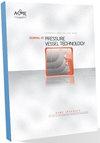Continuum Damage Mechanics Modeling Of High-Temperature Flaw Propagation: Application To Creep Crack Growth In 316H Standardized Specimens And Nuclear Reactor Components
IF 1.4
4区 工程技术
Q4 ENGINEERING, MECHANICAL
Journal of Pressure Vessel Technology-Transactions of the Asme
Pub Date : 2023-07-11
DOI:10.1115/1.4062953
引用次数: 0
Abstract
Predicting creep crack growth (CCG) of flaws found during operation in high-temperature alloy components is essential for assessing the remaining lifetime of those components. While defect assessment procedures are available for this purpose in design codes, these are limited in their range of applicability. This study assesses the application of a local damage-based finite-element methodology as a more general technique for the prediction of CCG at high temperatures on a variety of structural configurations. Numerical results for stainless steel 316H, which are validated against experimental data, show the promise of this approach. This integration of continuum damage mechanics (CDM) based methodologies, together with adequate inelastic models, into assessment procedures can therefore inform the characterization of CCG under complex operating conditions, while avoiding excessive conservatism. This article shows that such modeling frameworks can be calibrated to experimental data and used to demonstrate that the degree of tri-axiality ahead of a growing creep crack affects its rate of growth. The framework is also successfully employed in characterizing CCG in a realistic reactor pressure vessel geometry under an arbitrary loading condition. These results are particularly relevant to the nuclear power industry for defect assessment and inspections as part of codified practices of structural components with flaws in high-temperature reactors.高温裂纹扩展的连续损伤力学模型:在316H标准试样和核反应堆部件蠕变裂纹扩展中的应用
预测高温合金部件在使用过程中发现的蠕变裂纹扩展(CCG)对于评估这些部件的剩余寿命至关重要。虽然缺陷评估程序在设计规范中可用于此目的,但它们的适用范围是有限的。本研究评估了基于局部损伤的有限元方法的应用,作为一种更通用的技术,用于预测高温下各种结构构型的CCG。对316H不锈钢的数值计算结果与实验数据进行了验证,表明了该方法的可行性。因此,将基于连续损伤力学(CDM)的方法与适当的非弹性模型整合到评估程序中,可以为复杂操作条件下的CCG特征提供信息,同时避免过度保守。这篇文章表明,这样的建模框架可以校准到实验数据,并用于证明三轴的程度,在一个增长的蠕变裂纹影响其增长速度。该框架还成功地用于表征任意载荷条件下真实反应堆压力容器几何结构中的CCG。这些结果与核电工业的缺陷评估和检查特别相关,作为高温反应堆中有缺陷的结构部件的编纂实践的一部分。
本文章由计算机程序翻译,如有差异,请以英文原文为准。
求助全文
约1分钟内获得全文
求助全文
来源期刊
CiteScore
2.10
自引率
10.00%
发文量
77
审稿时长
4.2 months
期刊介绍:
The Journal of Pressure Vessel Technology is the premier publication for the highest-quality research and interpretive reports on the design, analysis, materials, fabrication, construction, inspection, operation, and failure prevention of pressure vessels, piping, pipelines, power and heating boilers, heat exchangers, reaction vessels, pumps, valves, and other pressure and temperature-bearing components, as well as the nondestructive evaluation of critical components in mechanical engineering applications. Not only does the Journal cover all topics dealing with the design and analysis of pressure vessels, piping, and components, but it also contains discussions of their related codes and standards.
Applicable pressure technology areas of interest include: Dynamic and seismic analysis; Equipment qualification; Fabrication; Welding processes and integrity; Operation of vessels and piping; Fatigue and fracture prediction; Finite and boundary element methods; Fluid-structure interaction; High pressure engineering; Elevated temperature analysis and design; Inelastic analysis; Life extension; Lifeline earthquake engineering; PVP materials and their property databases; NDE; safety and reliability; Verification and qualification of software.

 求助内容:
求助内容: 应助结果提醒方式:
应助结果提醒方式:


